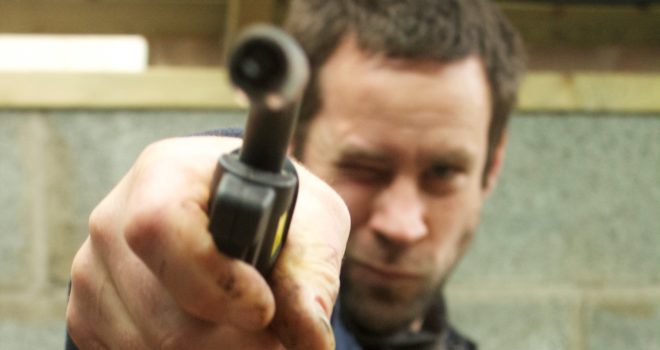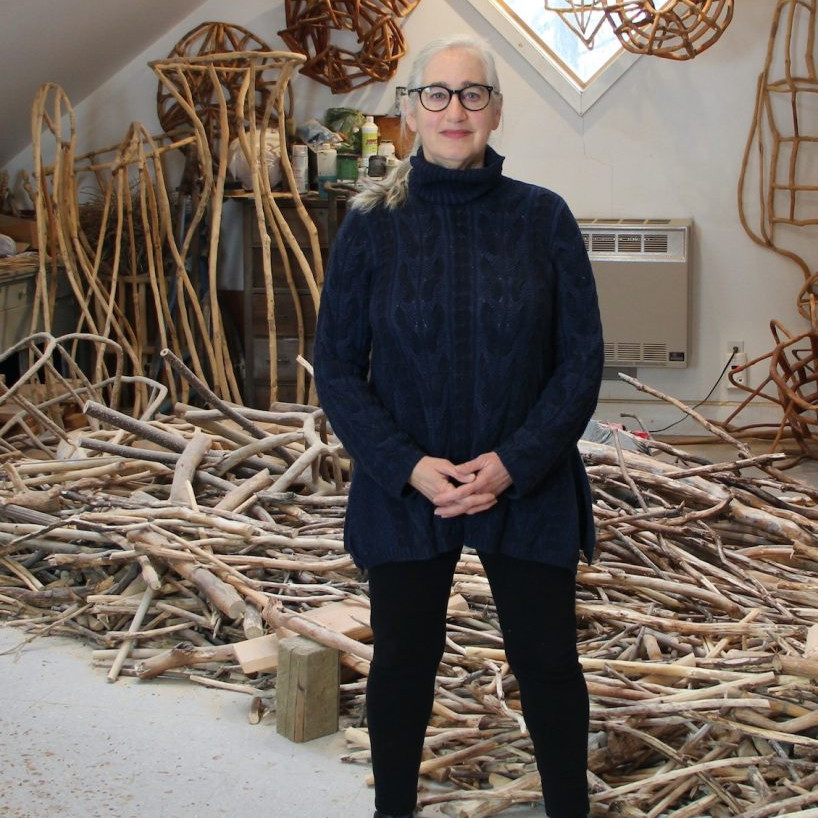John K Brown Scuptor - Llanarth, Wales, UK.
Can you give a short timeline as to how you became involved in sculpture using salvaged materials?
I’ve always wanted to be an artist. As a child I used my imagination for entertainment. I drew, painted and made things, nothing made me quite so happy.

Frogs 6″ x 5″ x 3″
At school I loved showing-off my skill at drawing – it gave me a huge thrill to see peoples disbelief at what I could do.
I went to college, initially specialising in illustration and later going on a degree course in Fine Art Painting. After “dropping-out” from that course I got a bit disillusioned with the industry and moved away from it.
I tried sticking at numerous different jobs which I thought might satisfy my creative impulse, such as prop-making, decorating, working in antiques auctioning as well as many others before eventually “dropping-out” again and living in the woods for two years in a tipi. There I found a new connection with nature, a fascination with the cycle of growth/deterioration and had a magical restructuring of my values.
I then moved to Wales and worked on the land. My mum talked me into attending college once more where I studied sculpture and learned welding.
A few years into the course, my younger brother died very suddenly. A little over 2 years later my mother died also. I was already struggling to stay with the course when my son was born.
I “dropped-out” again.
I went back to felling trees with a chainsaw (now supporting a family) and made carvings on the stumps for extra money. With some of this money I bought a crappy welder from a yard sale and started making small sculptures for presents and my own amusement.
I started sharing pictures of my work with my friends on social media and the whole thing has spiralled from there.
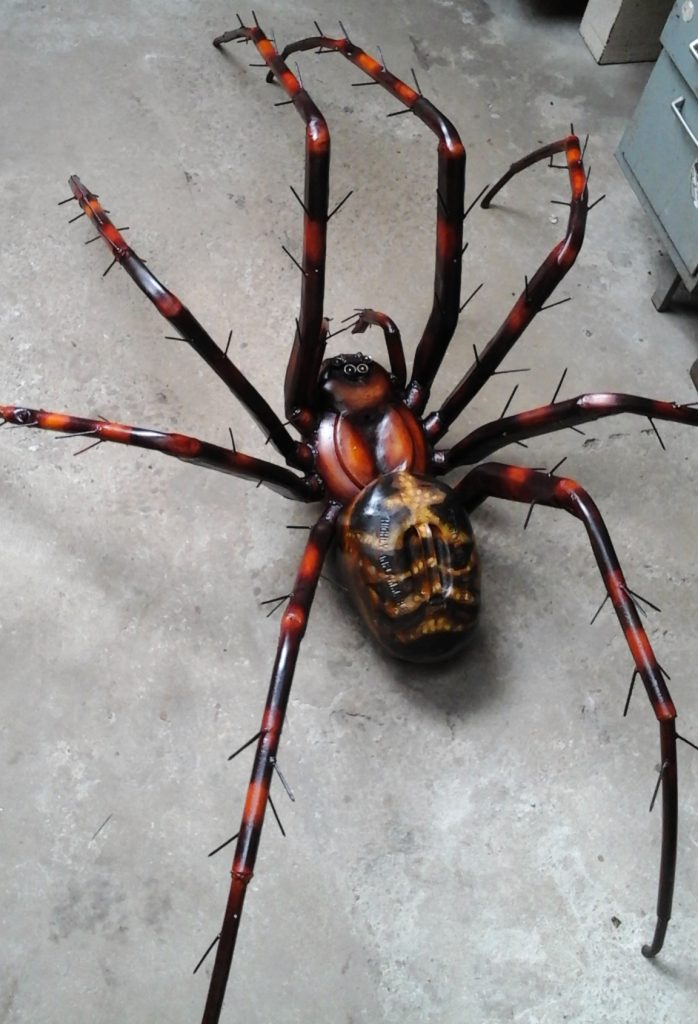
Cave Spider 8′ x 5′ x 2′
On one of the average pieces how many parts make up a whole?
Some of the smaller sculptures can incorporate as little as 11 parts, the biggest sculptures must have several hundreds.
What are your smallest sculptures?
I have welded butterflies that are life size and I also have welded grasshopper sculptures that are 3 inches long (including the antennae).
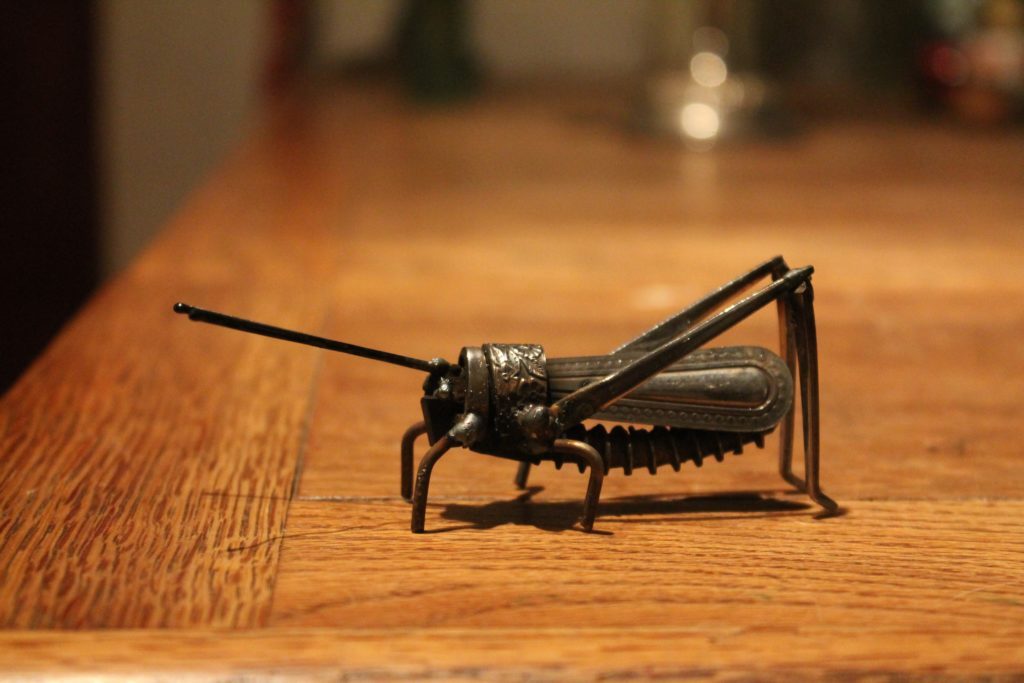 Does the size of the work indicate the size in real life?
Does the size of the work indicate the size in real life?
No, not at all, scale is a facet of the design that I really enjoy playing with. If the proportions of a piece are correct then it can be really difficult to tell from a photo what size a piece is – I’ve found that even first hand it can mess with the viewers perspective and sense of relative scale, this makes me feel like I have done my job.
Expand on the influence the Land Art movement has had on your work?
As an energetic and boisterous child growing up in the county of Wiltshire I had a passion for the landscape – being out in it, being part of it. The (natural) landscape, for me, represented escape from repressive human situations, freedom to move and think. I was always drawn to being outside and working with a connection to the natural world just feels like a progression to that.
When I first discovered artists such as Andy Goldsworthy and David Nash I felt an instinctive connection with their practices. Here were artists that had abandoned the studio and the gallery to use the landscape as their exhibition space. They were taking human notions of formality and transposing it onto natural spaces. There seemed to me something much more authentic about making art out of ones surroundings.
When I moved to Wales in 2006 it was because I wanted to live in a more remote place than I had known previously. I also saw it as an opportunity to start making pieces of land art for myself – I learned about green woodworking, basketry, timber –framing, woodcarving, anything I could. I earned money hedge-laying, thinning trees and landscaping by hand. In my spare time I walked, photographing and collecting interesting “objet d’art”, wood forms and rusted metal – fragments of machines and agricultural waste left to rot in the woods and on the beaches.
I started a sculpture course at Carmarthen School of Art and I naturally drew on these experiences and objects that had inspired me. This time I wanted to bring the authenticity I had encountered, which represented the cycle of growth deterioration, back to the studio, back to the gallery.
Discuss ‘Peacock Butterfly (chainsaw Butterfly) and Green Hairstreak Butterfly.
I have made Peacock Butterflies in a variety of different sizes. I have made several whose wingtips stand about 20 inches tall. So far this design is the largest.
The abdomen was made from (scrap) flat bar which was cold-beaten into rings that were then welded together. The tip of the abdomen is a sea-worn bolt (from the local sea defences that were replaced quite recently). The legs, antennae and proboscis were all made from a mixture of bolts, round bar and heavily threaded screws.
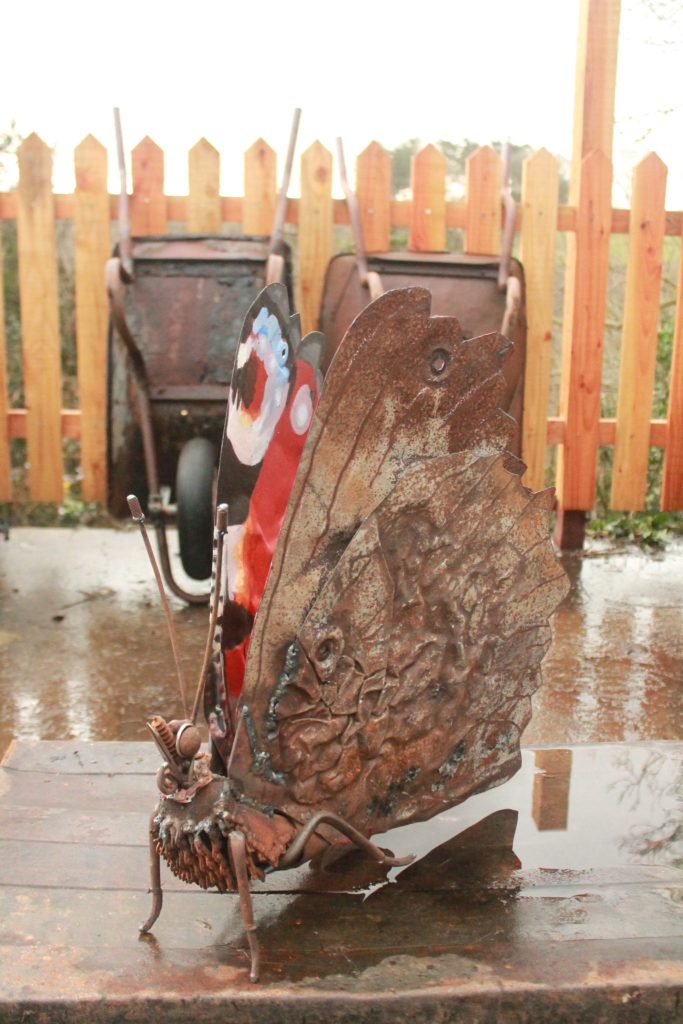
One of the main features of this piece was the fur around its thorax which I simulated using closely grouped rows of chainsaw chain. The undulating teeth gave it a “fluffy” appearance. I also enjoyed the contrast of this aggressive, industrial material with a subject that appears so fragile and serene. The other main focal point was the wings that were made from rusted-through wheelbarrow buckets, beaten flat and then painted with oil paints. This really embodies a process that is core in my work – taking rotten useless matter and by reframing, elevating it to a state of beauty.
The Green Hairstreak sculpture was made as a commission for someone who loved the Holly Blue Butterfly sculpture but was keen to have a green version. I am open to the input of others, but I was adamant that it should be an actual species. I looked at native British butterflies – of which, very few are green. This is what we decided on.
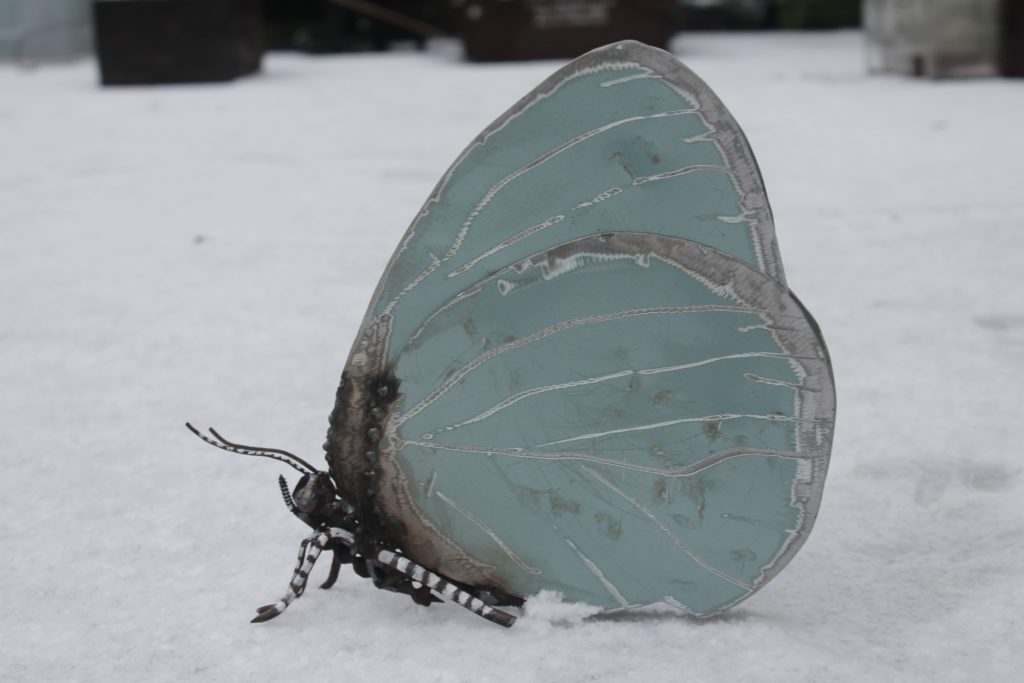
The abdomen, thorax, head, legs and antennae are a mixture of small pieces of scrap steel such as: nuts, bolts, nails, screws and ball-bearings. The legs and antennae of this species are quite stripey, so these were painted using rust-resistant paint.
The wings are made from a car panel from the scrap yard. I really like the notion that materials like these have an entire other history before their incorporation.
How accurate are you in the sculpting of your insects, bugs and butterflies?
Well, I try to be as accurate as I can be, within the context of the actual piece. With some pieces the finish or painting may be more important than the surface texture or other physical details.
Scale puts a restriction on detail. I made a horse that stood 10inches at the shoulder and so I specifically used pieces of metal that already had texture or shape to describe some of the detail. On the other hand I recently made a spider that has an 8ft leg span and I was able to weld the hairs on its legs using a load of 3 inch nails I got from a skip.
You also use oil paint on your work, explain when and why?
I love painting, after drawing it’s probably my strongest suit. I studied Fine Art Painting at Cheltenham College and I also worked (briefly) as an assistant to the mural painter Rodney Booth-Jones RA and for a time as prop-maker too, so I try and work it in where I can. I use it to embellish my sculptures with pattern and colours that would be impossible to achieve using just scrap. Sometimes I use colour as a contrast to the rusted surface of other components, sometimes it becomes the focal point of a piece.
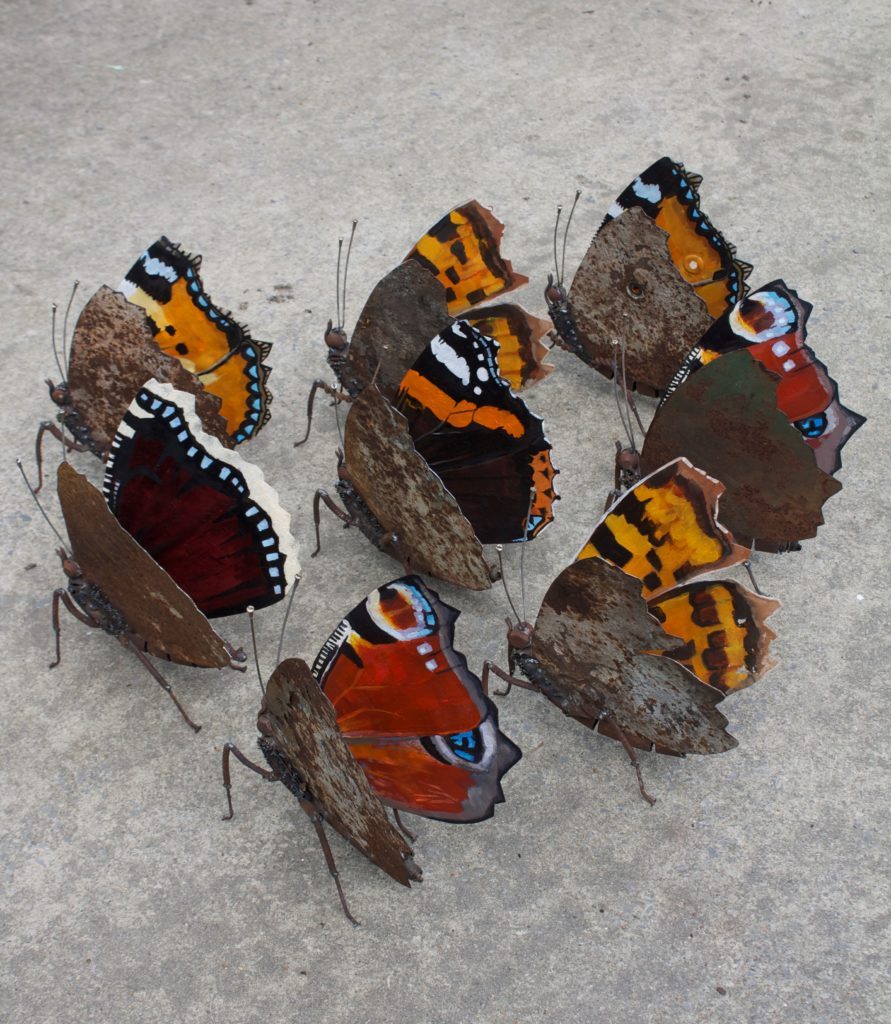
Butterflies 9″ x 6″ x 9″
Painting gives me a broader range of possibilities as well as fulfilling something from within.
Can you discuss the iridescent colour on your ‘Praying Mantis’ and how this is achieved?
When stainless steel is heated by welding, the metal nearest the heat can change from being mirrored to a range of different iridescent hues. This depends on a number of highly variable factors but is mostly governed by temperature. The mirror finish of the stainless steel in this piece also reflects any colours around it. So the praying mantis sculpture changes colour with its surroundings in a chameleon-like way.
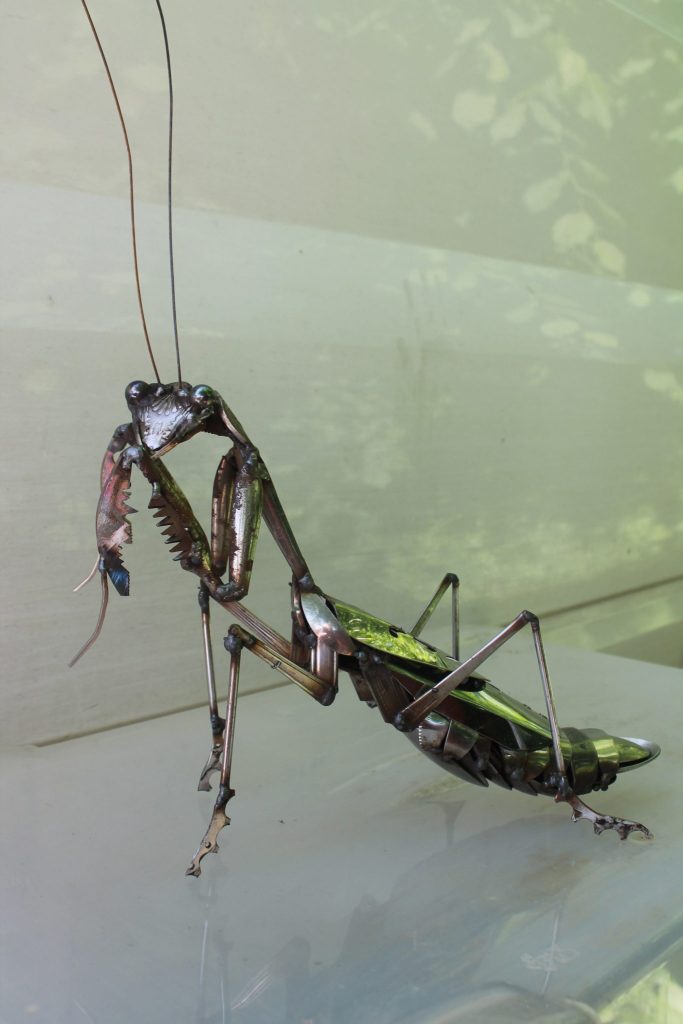
Praying Mantis 12″ x 5.5″ x 16″
Expand on your animals.
Horses
I have had a huge interest in horses since I was a child. Wiltshire and the surrounding counties are well known for horse breeding and racing. Horses were around a lot, so I think they have registered strongly in my unconscious. The area also has numerous “White Horses” – enormous horse effigies carved into chalk hills, some of which date back to the Iron Age. These incredible creatures have held special significance for so long, that for me they are irresistible as a subject and as a metaphor.
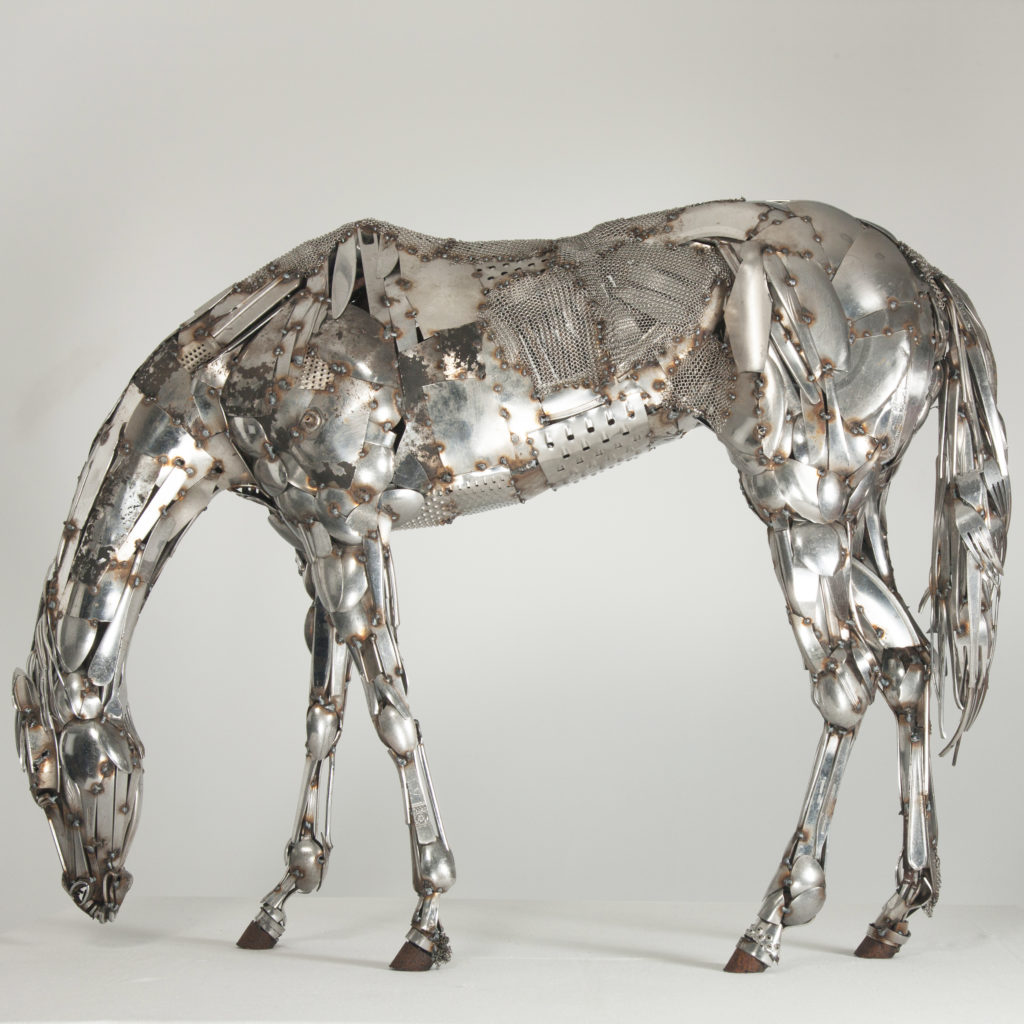
‘Graze’ 29″ x 10″ x 28″
In 2014 I made a small horse sculpture called ‘Poohka’ which was based on a character from Celtic mythology, a shape-shifter which favoured the form of a black horse. A benevolent spirit which could be even helpful to people, it was said to be capable of exacting terrifying vengeance upon farmers who took too much from nature.
I revisited the subject in 2015 when I made ‘Graze’ a thoroughbred racehorse made from scrap cutlery, and other scrap stainless steel including pans, knives and abattoir chainmail – all various objects and materials which might have been used to dismantle and fragment the horses which (notoriously) ended up in the human food chain here.
Dogs
Much like horses, dogs of all the domestic animals have one of the closest relationships with humans and their proximity is reflected by their place in our culture.
One thing that constantly intrigues me about dogs is that, despite many similarities, (many superimposed) is how intrinsically different their existential experience must be.
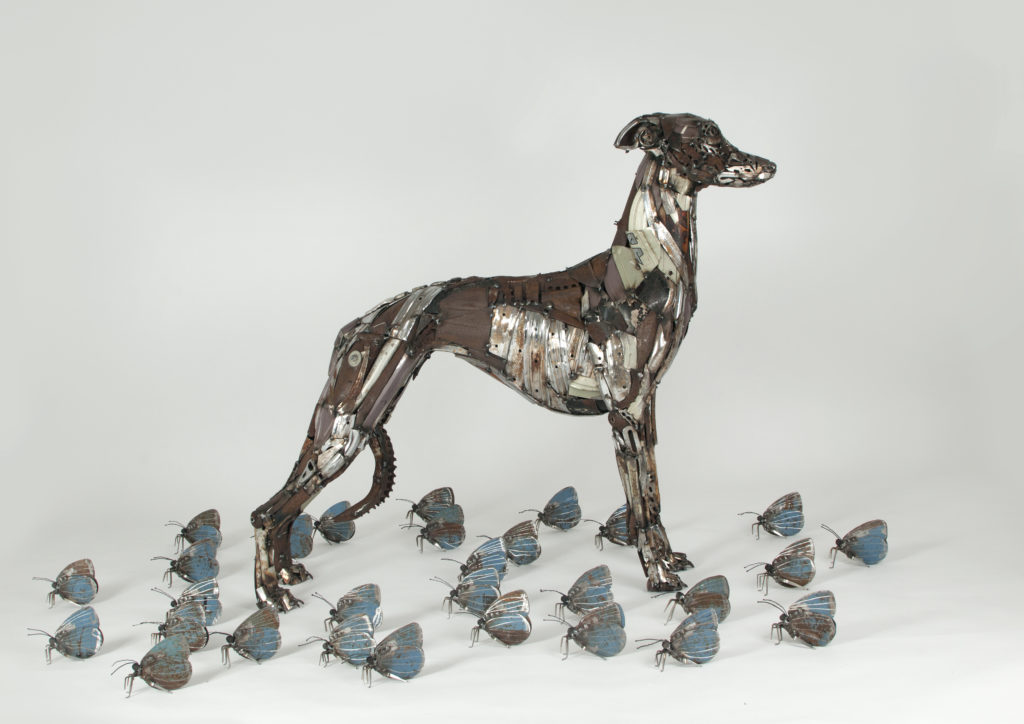
‘Run’ – life-sized whippet sculpture made from vintage bicycles
This year I made a sculpture called ‘run’ which is a running dog made from old bicycle parts. It represents a creature in the prime of its life: focused, alert – ready to hit top speed at any moment. The subject contrasts with the material – old redundant bicycles, which could be made to work again, but are considered worthless by the ever- expanding, modern, human world.
How important is location for your work?
Storage of materials
Inspiration
Suitable site for a studio
This location is everything to my work at the moment.
Wales is more wild, more remote and rugged than much of England, including where I grew up. Much of the land is undeveloped and too steep to farm, so to a degree protected and in turn, a habitat. The wildlife inspires me and the natural spaces facilitate a calm, creative mind. Scrap metal seems to be easy to acquire – although health and safety regulations prevent me from getting anything from the tip – which is madness in my opinion!
Storage of materials can be quite tricky due to having little space to do so and I work from a pile of materials that I think most people would think was impossibly small.

Adder – 38″ x 22″ x 8″
My studio is close to our home, which is great because I can spend the maximum amount of time with my partner and our son. This is a real bonus when I’m spending as much as 35-40 hours a week grinding and welding.
Birds – you don’t restrict yourself to native birds, of Britain, e.g. ‘Magpie’ discuss?
I won’t restrict myself to native birds, although I think that is all I’ve made so far. Some birds that people think of as intrinsically British actually have really global distribution such as the Kingfisher and the Magpie (yes we do have them here!) – although several American followers on social media have called the sculpture a “Bluejay”.
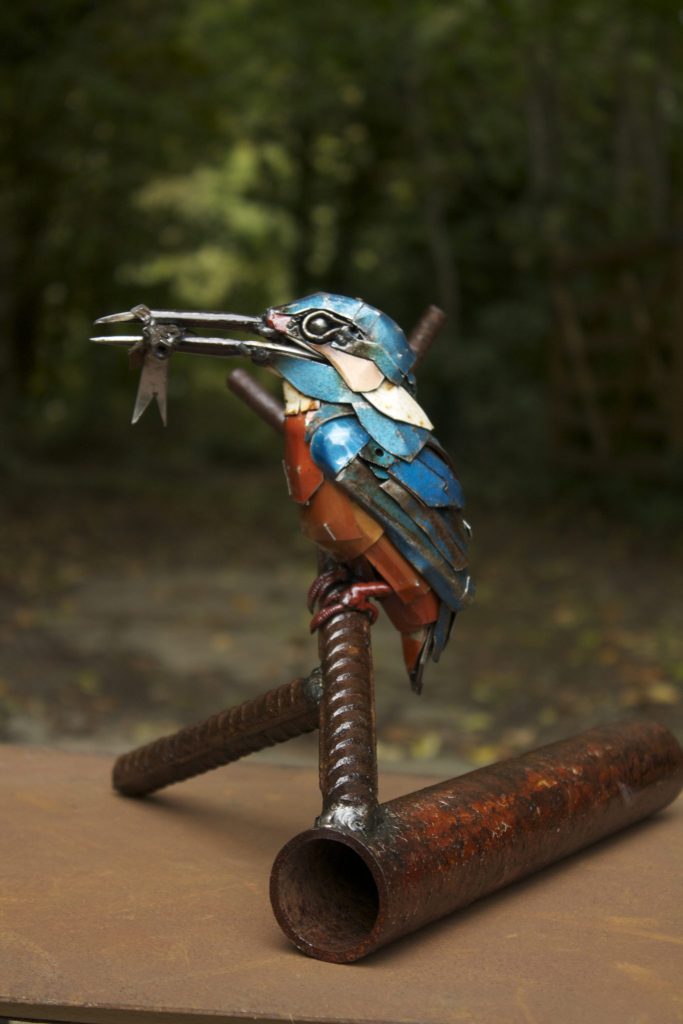
Kingfisher – made with scrap metal fragments (detail).
Many creatures such as birds and butterflies transcend political/national borders and are loved and recognised by people of many nations. This has become a theme in some of my recent work.
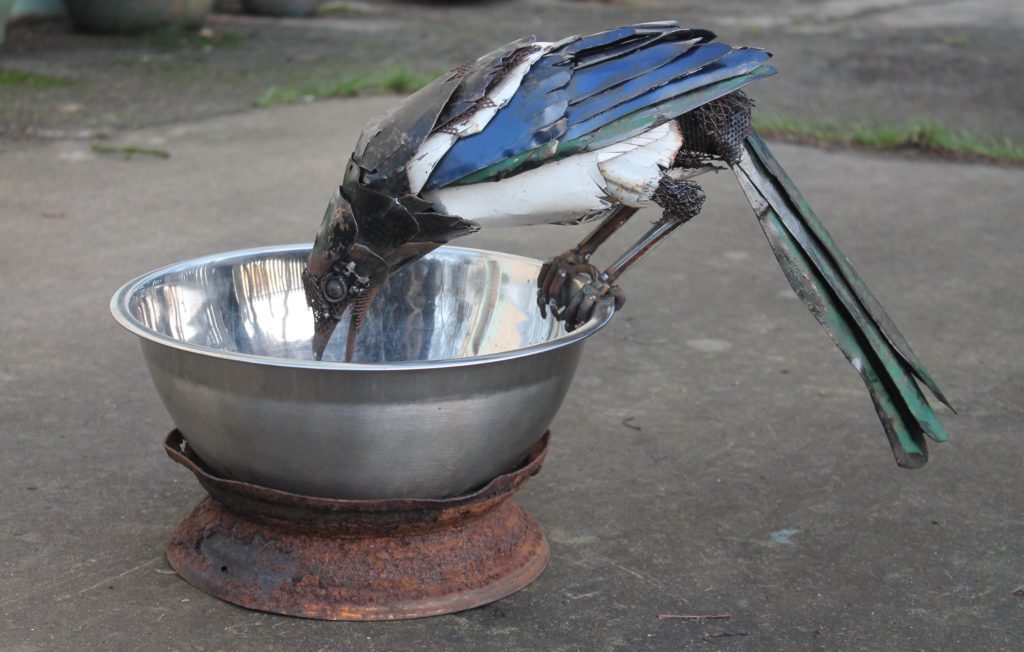
Magpie 20″ x 10″ x 14″
Do you do commissions? If so what are your boundaries?
I do presently undertake commissions, but I have to like/be inspired by the idea.
What are you currently working on?
I have a commission list that is as long as my arm (it’s nice to be popular!). I presently have a large piece of sculpture called ‘Swarm’ in Windsor Great Park in London.
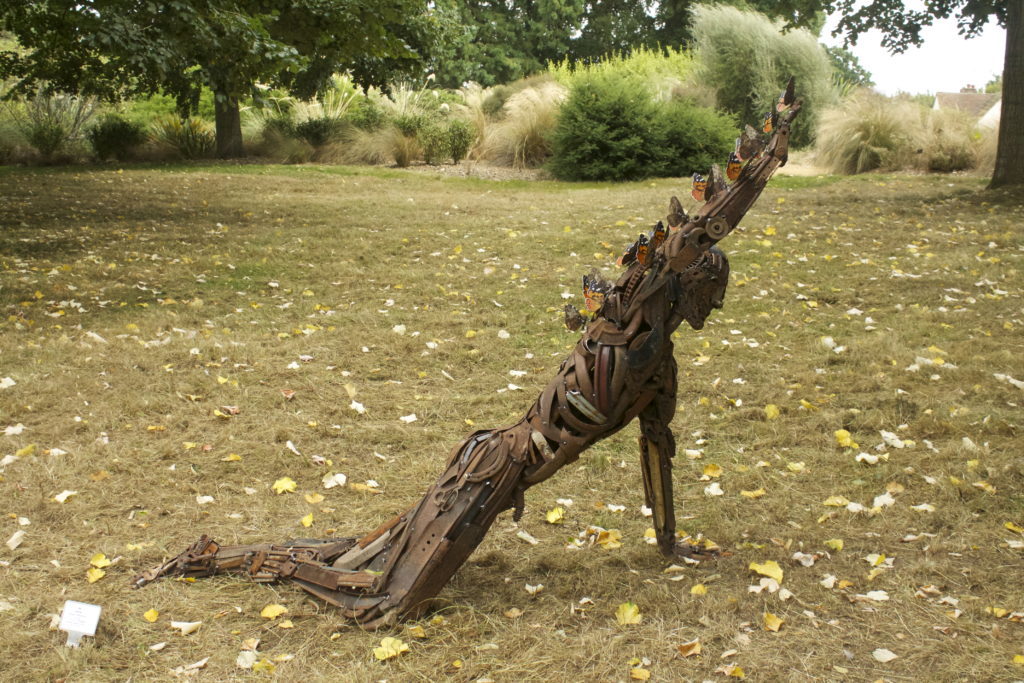
Swarm – 6ft x 1ft x 5ft (currently exhibited in Windsor Great Park)
I am also very pleased to part of a select group of artists from around the world exhibiting at Oil Gallery in Hungerford, Berkshire (UK) and this is giving me a chance to make some really quite special pieces of sculpture like ‘Graze’.
I am also currently discussing the possibility of a solo show next year.
Contact details:
John K Brown
Interview by Deborah Blakeley, December, 2016
Think a colleague or friend could benefit from this interview?
Knowledge is one of the biggest assets in any business. So why not forward this on to your friends and colleagues so they too can start taking advantage of the insightful information the artist has given?
Other artists you may be interested in:


